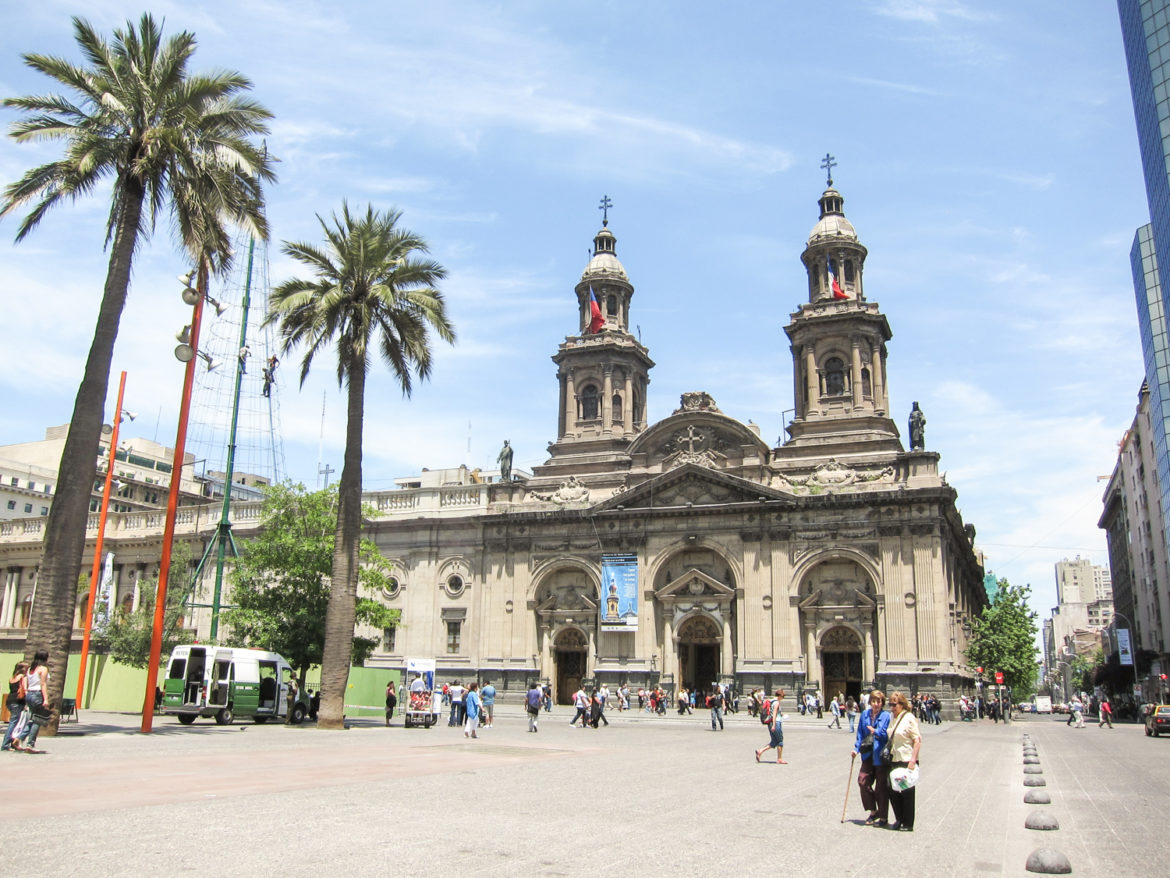Elegant colonial architecture, bustling markets and the infamous lomito sandwich are just a few things that encapsulate Santiago.
Visiting a capital city can often be intimidating, but for some reason, Santiago is manageable. Home to over a quarter of the country’s population, it feels more energetic than overcrowded.
We arrived in Santiago after an eight-hour bus ride from Mendoza (short by South American standards.) As we made our way along winding roads, we enjoyed spectacular scenery of the snow-covered Andes mountains. All in all, it was a smooth trip with the exception of an unnerving border crossing with plenty of armed security. While waiting in line to submit our passports, we noticed photos on the wall of people who had been arrested for attempting to smuggle drugs into the country. In side-by-side photos, a seemingly pregnant woman had actually just duct taped drugs across her stomach. Yikes.
Once in Santiago, we checked into Hostal Tales in the artsy, historic neighborhood of Barrio Brasil. From there, it was just a 20 minute walk across the Calle Huerfanos footbridge to the city center. The Plaza de Armas is the city’s main social hub – a lush, tree-lined central square dominated by the Metropolitan Cathedral, the plaza’s oldest building. Against the backdrop of neoclassical buildings and majestic statues, you get a glimpse of the different lives of everyday people. Delivery people lugging wooden carts weave gracefully between busy professionals on their way to work. Elderly women catch up on the latest gossip, while others relax on a park bench beside bubbling fountains.
Just a few blocks from Plaza de Armas is the frenetic Mercado Central.
Here, a complex of hundreds of stalls generates an enormous amount of fresh fish, produce and handicrafts. While catering to tourists, we found plenty of locals and expats shopping as well. Amidst the frenzy, we tried to stay out of the way in between photo ops. Thankfully, a fish vendor happily volunteered to pose for us, holding up his prized catch of the day: a three-foot angler fish.
Across the Rio Mapocho, we made our way to La Vega, yet another enormous market. While the focus of Mercado Central is primarily seafood, La Vega touts its fresh fruits and vegetables. Of the two, La Vega is considered more authentic with cheaper prices. Here, we sought out Carmen’s, a humble eatery that Anthony Bourdain visited on his show, No Reservations. While not as adventurous as he was (he ordered the hoof soup and large intestine platter), we enjoyed pastel de choclo, a traditional Chilean corn pie made of roasted beef, vegetables and creamed corn.
Eating was definitely a focal point during our time in Santiago.
Every morning, we picked up bread from Panaderia y Pasteleria San Camilo. We ate in tranquil Plaza Brasil then went in search of the ubiquitous cafe con leche. Lunch typically consisted of street food, including a fair amount of “el completos,” Chile’s version of a classic loaded hot dog.
Perhaps our most memorable meal was at Fuente Alemana, a traditional diner that features what many consider to be the world’s greatest sandwich. For over 50 years, they’ve served up their version of the iconic “lomito,” an authentic Chilean sandwich made of copious amounts of smoked pork, avocado and mayonnaise on fresh, homemade bread. With uniformed waitresses in hairnets and an ambience that likely hasn’t changed since it first opened, it definitely feels authentic. We wisely chose to split one lomito, and suffice it to say, it was one of the best, most filling sandwiches we’ve ever eaten.
Like most of South America, lunch tends to be the big meal of the day. Though we did enjoy a memorable dinner at Las Vacas Gordas. The traditional steakhouse offers steaks grilled to perfection at reasonable prices. To paraphrase Anthony Bourdain, what better way to top meat than by having more meat? Especially when accompanied with Chilean wine. When in Santiago…
One thing we didn’t partake in is the city’s café con piernas (“coffee with legs.”) This uniquely Chilean tradition involves skimpily-clad female waitresses in high heels serving coffee to (typically) male patrons. At certain establishments, the clientele is offered more than just coffee.
In addition to eating, Santiago has a variety of interesting outdoor and cultural experiences.
We enjoyed visiting Cerro Santa Lucia, a lovely hilltop park on the eastern side of downtown. It’s actually the remnant of a 15 million year old volcano. With its manicured landscaping, winding stairways and beautiful views, it’s the perfect place to while away an afternoon.
You don’t have to be a history buff to appreciate the Museo Chilean de Arte Precolombino. This fantastic museum features an extensive collection of pre-Colombian artworks and artifacts from Central and South America. From the beginnings of pottery and textile production to the arrival of the European invaders, it strives to show the wide diversity of the American peoples.
For insight into local culture, the Pablo Neruda Foundation offers tours to three eclectic homes of former Senator of Chile and Noble Prize of Literature winner, Pablo Neruda. We visited the Casa Museo La Chascona, the home Neruda built for his mistress at the time. Its quirky decor includes paintings of Chilean and foreign artists, as well as an African carved wood collection. In that same neighborhood, Barrio Bellavista, we wandered the streets taking in the graffiti murals, lively bars and interesting shops. We also enjoyed many happy hours along Pio Nino, especially after sunset.
One afternoon, we made the scenic hike through Parque Metropolitano de Santiago to the top of Cerro San Cristobal. Here, a giant statue of the Virgin Mary marks the site known as the Sanctuary of the Immaculate Conception. As the sun began to set, we looked out to the city stretched out before us. Away from the bustling streets and traffic below, we sat among the fragrant gardens of the sanctuary, looking at a capital city that appeared incredibly peaceful.

